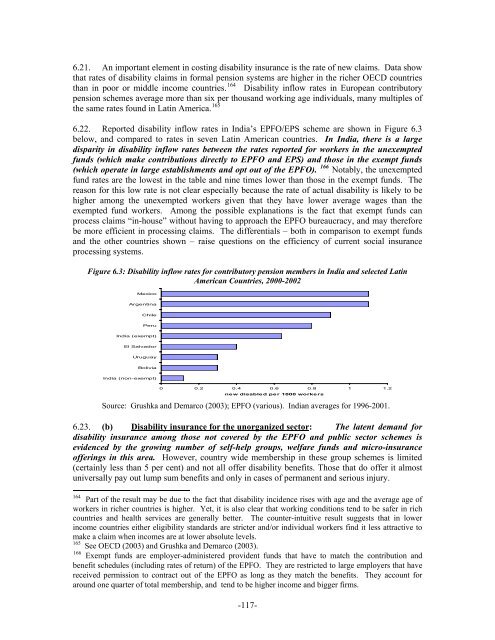People with Disabilities in India: From Commitment to Outcomes
People with Disabilities in India: From Commitment to Outcomes
People with Disabilities in India: From Commitment to Outcomes
Create successful ePaper yourself
Turn your PDF publications into a flip-book with our unique Google optimized e-Paper software.
6.21. An important element <strong>in</strong> cost<strong>in</strong>g disability <strong>in</strong>surance is the rate of new claims. Data show<br />
that rates of disability claims <strong>in</strong> formal pension systems are higher <strong>in</strong> the richer OECD countries<br />
than <strong>in</strong> poor or middle <strong>in</strong>come countries. 164 Disability <strong>in</strong>flow rates <strong>in</strong> European contribu<strong>to</strong>ry<br />
pension schemes average more than six per thousand work<strong>in</strong>g age <strong>in</strong>dividuals, many multiples of<br />
the same rates found <strong>in</strong> Lat<strong>in</strong> America. 165<br />
6.22. Reported disability <strong>in</strong>flow rates <strong>in</strong> <strong>India</strong>’s EPFO/EPS scheme are shown <strong>in</strong> Figure 6.3<br />
below, and compared <strong>to</strong> rates <strong>in</strong> seven Lat<strong>in</strong> American countries. In <strong>India</strong>, there is a large<br />
disparity <strong>in</strong> disability <strong>in</strong>flow rates between the rates reported for workers <strong>in</strong> the unexempted<br />
funds (which make contributions directly <strong>to</strong> EPFO and EPS) and those <strong>in</strong> the exempt funds<br />
(which operate <strong>in</strong> large establishments and opt out of the EPFO). 166 Notably, the unexempted<br />
fund rates are the lowest <strong>in</strong> the table and n<strong>in</strong>e times lower than those <strong>in</strong> the exempt funds. The<br />
reason for this low rate is not clear especially because the rate of actual disability is likely <strong>to</strong> be<br />
higher among the unexempted workers given that they have lower average wages than the<br />
exempted fund workers. Among the possible explanations is the fact that exempt funds can<br />
process claims “<strong>in</strong>-house” <strong>with</strong>out hav<strong>in</strong>g <strong>to</strong> approach the EPFO bureaucracy, and may therefore<br />
be more efficient <strong>in</strong> process<strong>in</strong>g claims. The differentials – both <strong>in</strong> comparison <strong>to</strong> exempt funds<br />
and the other countries shown – raise questions on the efficiency of current social <strong>in</strong>surance<br />
process<strong>in</strong>g systems.<br />
Figure 6.3: Disability <strong>in</strong>flow rates for contribu<strong>to</strong>ry pension members <strong>in</strong> <strong>India</strong> and selected Lat<strong>in</strong><br />
American Countries, 2000-2002<br />
Mexico<br />
Argent<strong>in</strong>a<br />
Chile<br />
Peru<br />
<strong>India</strong> (exempt)<br />
El Salvador<br />
Uruguay<br />
Bolivia<br />
<strong>India</strong> (non-exempt)<br />
0 0.2 0.4 0.6 0.8 1 1.2<br />
new disabled per 1000 workers<br />
Source: Grushka and Demarco (2003); EPFO (various). <strong>India</strong>n averages for 1996-2001.<br />
6.23. (b) Disability <strong>in</strong>surance for the unorganized sec<strong>to</strong>r: The latent demand for<br />
disability <strong>in</strong>surance among those not covered by the EPFO and public sec<strong>to</strong>r schemes is<br />
evidenced by the grow<strong>in</strong>g number of self-help groups, welfare funds and micro-<strong>in</strong>surance<br />
offer<strong>in</strong>gs <strong>in</strong> this area. However, country wide membership <strong>in</strong> these group schemes is limited<br />
(certa<strong>in</strong>ly less than 5 per cent) and not all offer disability benefits. Those that do offer it almost<br />
universally pay out lump sum benefits and only <strong>in</strong> cases of permanent and serious <strong>in</strong>jury.<br />
164 Part of the result may be due <strong>to</strong> the fact that disability <strong>in</strong>cidence rises <strong>with</strong> age and the average age of<br />
workers <strong>in</strong> richer countries is higher. Yet, it is also clear that work<strong>in</strong>g conditions tend <strong>to</strong> be safer <strong>in</strong> rich<br />
countries and health services are generally better. The counter-<strong>in</strong>tuitive result suggests that <strong>in</strong> lower<br />
<strong>in</strong>come countries either eligibility standards are stricter and/or <strong>in</strong>dividual workers f<strong>in</strong>d it less attractive <strong>to</strong><br />
make a claim when <strong>in</strong>comes are at lower absolute levels.<br />
165 See OECD (2003) and Grushka and Demarco (2003).<br />
166 Exempt funds are employer-adm<strong>in</strong>istered provident funds that have <strong>to</strong> match the contribution and<br />
benefit schedules (<strong>in</strong>clud<strong>in</strong>g rates of return) of the EPFO. They are restricted <strong>to</strong> large employers that have<br />
received permission <strong>to</strong> contract out of the EPFO as long as they match the benefits. They account for<br />
around one quarter of <strong>to</strong>tal membership, and tend <strong>to</strong> be higher <strong>in</strong>come and bigger firms.<br />
-117-










